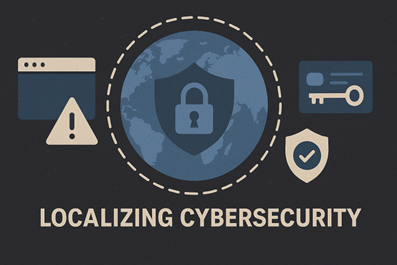Localizing cybersecurity: adapting global policies to regional realities

If your company operates across multiple countries, you probably already know that when it comes to cybersecurity, there’s no such thing as a one-size-fits-all solution.
It might be tempting to roll out a single global policy and call it a day. But what works for a team in Germany might confuse users in Brazil – or worse, break local laws in China. Between regional regulations, cultural differences and the way people use technology in different parts of the world, cybersecurity quickly becomes a moving target.
That’s where localization comes in. And no, we’re not just talking about translating a few security training videos or swapping out currencies on your login screens. We’re talking about truly adapting your cybersecurity strategy – the policies, the processes, even the tools – to fit local expectations, legal requirements and threat landscapes.
In this article, we’ll explain why localizing your cybersecurity approach isn’t just an option – it’s a must. Because at the end of the day, protecting your business means meeting people where they are.

Why one-size-fits-all doesn’t work in cybersecurity
Why one-size-fits-all doesn’t work in cybersecurity
It’s easy to see the appeal of a single, global cybersecurity policy. It feels clean, consistent and easy to manage, especially if you’re scaling fast or trying to keep a lean security team. But here’s the catch: real-world cybersecurity isn’t just about systems and software. It’s about people, laws and local context – and those vary wildly from one country to the next.
Let’s say your HQ is in the US, and you’ve crafted a detailed data protection policy based on American standards. Now you expand into the EU, and suddenly, you’re dealing with GDPR, which has stricter consent requirements and heavy penalties. That same US-based policy? It might not just be ineffective – it could be non-compliant.
Here are a few common problems with global, one-size-fits-all approaches:
- Compliance conflicts: local laws like GDPR, PIPL (China) or LGPD (Brazil) may require things your global policy doesn’t cover.
- Cultural disconnects: security awareness training that uses humor or confrontation might fall flat in some cultures.
- Language barriers: security policies written only in English often get ignored or misunderstood in non-English speaking regions.
- Operational friction: expecting everyone to follow the same incident response process, no matter their time zone or infrastructure, slows things down when it matters most.
The result? Employees are confused, adoption is inconsistent and your company ends up exposed to risk in places you didn’t anticipate.

The legal landscape: compliance is regional
The legal landscape: compliance is regional
Cybersecurity isn’t just about keeping out the bad guys – it’s also about staying on the right side of the law. It’s worth remembering that the rules change depending on where you’re operating.
Most countries now have some form of data protection or cybersecurity regulation, and while many of them share common goals, the specifics vary a lot. What’s perfectly acceptable in one region might be a violation in another. And ignoring those differences can cost you…
Let’s break it down:
- Europe – GDPR (General Data Protection Regulation): requires companies to get clear consent, minimize data collection and notify authorities of breaches within 72 hours.
- United States – CCPA/CPRA (California): focuses on consumer rights like knowing what data is collected and opting out of its sale. Data laws vary by state, there’s no single national standard.
- Brazil – LGPD (Lei Geral de Proteção de Dados): similar to GDPR but requires a legal basis for data collection and mandates local data protection officers in many cases.
- China – PIPL (Personal Information Protection Law): it places heavy restrictions on data transfers outside China and emphasizes government oversight.
- Singapore – PDPA (Personal Data Protection Act): encourages responsible data management and includes mandatory breach notifications.
So what does this mean for your cybersecurity policy? Mainly that you can’t just copy-paste your policy from HQ. Moreover, your incident response plan needs localization. Some regions require you to report breaches to authorities or users within very specific timeframes. Also, data residency matters. More and more countries are requiring that citizen data stays within their borders. That impacts your cloud infrastructure, backups and vendor choices.

Localizing cybersecurity awareness and training
Localizing cybersecurity awareness and training
You can have the strongest cybersecurity tools in the world, but if your people aren’t trained properly, they’ll still click the wrong link or fall for a phishing scam. And while most companies do invest in employee training, they often assume everyone learns the same way, in the same language, with the same cultural context.
Spoiler alert: they don’t.
Just like your policies, your cybersecurity training needs to be localized to actually stick. That means going beyond simply translating the content. It’s about making the training feel relevant, understandable and actionable.
Localization makes a difference, because language isn’t just words. A direct translation from English might sound robotic or confusing in another language. Worse, it could miss nuances and make the training ineffective. It is also worth noting that cultural norms shape behavior. In some regions, employees might be uncomfortable reporting mistakes or suspicious activity, especially if there’s a fear of punishment or loss of face. In some, humor might be a great tool to keep people engaged—while in others, it might feel inappropriate or distracting. Please also note that threats vary by region. A phishing simulation using fake US bank emails won’t resonate with employees in Poland or India. People need realistic, locally relevant scenarios.
When you take the time to localize your cybersecurity training, your employees don’t just read the information – they understand it, relate to it and, most importantly, act on it.

Regional threat models and attack patterns
Regional threat models and attack patterns
Cyber threats aren’t one-size-fits-all either. The types of threats your team in the UK faces might look very different from what your teams in Southeast Asia or South America are dealing with. And if you’re basing your entire cybersecurity playbook on data from your headquarters, you’re likely leaving major blind spots in the regions where you’re growing fastest.
Let’s look at a few regional threat differences:
- Europe: attackers often exploit strict data privacy rules like GDPR. One common trick? Fake emails pretending to be from data protection authorities, threatening fines unless users “confirm” personal information.
- Southeast Asia: SMS-based scams and mobile banking fraud are rampant. Phishing here often involves impersonating government agencies or local financial apps.
- Latin America: ransomware attacks are on the rise, and many local businesses are targeted through supply chain vulnerabilities or outdated software.
- North America: spear phishing and business email compromise (BEC) are huge problems – especially in sectors like healthcare, finance and education.
So what can you do about it? Regional threat intelligence is key. Don’t rely solely on global reports. Tap into local sources: government cybersecurity centers, industry ISACs or regional security forums to stay on top of what’s trending. You can also adapt your detection tools, which should be tuned to regional indicators of compromise (IOCs). That means monitoring for local domain names, language patterns in phishing emails and region-specific malware strains. We would also advise to prioritize high-risk areas. If you’re expanding into a region with a known threat pattern, strengthen defenses there first: better backups, endpoint hardening and stronger MFA policies.
Bottom line? Understanding what threats look like around the world helps you prepare better and keeps your entire company safer, no matter the zip code.

Implementing localized cybersecurity frameworks
Implementing localized cybersecurity frameworks
We’ve established that cybersecurity needs to be localized. But how do you actually do that without turning your entire security strategy into a messy patchwork? The key is finding the right balance between central oversight and local flexibility.
Think of it like a global restaurant chain: the core recipe and brand stay the same, but the menu adapts depending on where you are. Your cybersecurity framework can work the same way.
Start with a global foundation. Your core principles – like access control, encryption standards, incident response protocols – should be consistent across the board. This ensures there’s a reliable baseline and keeps things manageable.
Then customize for local execution. Here’s where the magic happens:
- Policies & procedures: localize policies to meet regional laws and operational norms. That might mean adjusting breach notification procedures, acceptable use guidelines or device management rules to reflect what’s realistic and legal in-country.
- Technology setup: configure your tools to respond differently based on region.
- Team structure: having regional security leads can make a big difference. They understand the local environment, speak the language and can bridge the gap between your central security team and local staff.
- Hosting and infrastructure: in some cases, you’ll need to consider data residency – keeping user data physically located within a particular country to comply with local laws. That affects cloud provider choice, backup locations and even logging infrastructure.
Don’t wait until you expand to localize your security framework. Build in flexibility from day one – it’s much easier to adapt when localization is part of your foundation, not an afterthought.

Localizing cybersecurity – conclusion
Aploq is here to help
Cybersecurity is no longer just about firewalls and passwords – it’s about people, places and policy. And in a world where businesses span continents, local context matters more than ever.
Trying to enforce a single, rigid security approach across all regions might seem efficient, but it often leads to gaps in compliance, disengaged employees and overlooked risks. From legal requirements to cultural norms and region-specific threat patterns, the differences are real and ignoring them puts your entire organization at risk.
By localizing your cybersecurity strategy, you’re not just checking a box. You’re building trust, reducing risk and creating a security culture that actually works for your global workforce.
So the next time you roll out a policy or training module, ask yourself: will this make sense to someone in another country, speaking another language, working in a different culture? If not, it might be time to localize.
If you need help with that, contact Aploq – we understand that in cybersecurity, the best global strategy is one that respects the local stage. We are here to assist you with responsible localization that complies with local standards.

